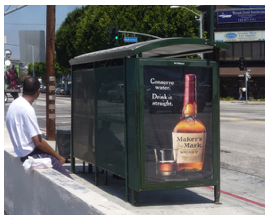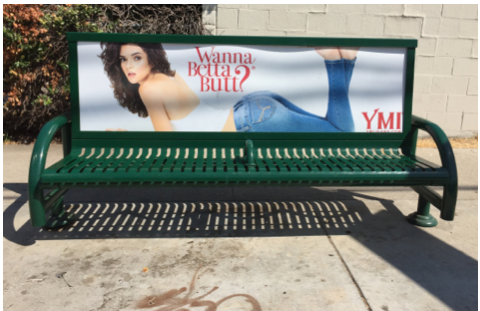CommentsBILLBOARD WATCH--The news that LA’s street furniture program is bringing less than $4 million a year to the city treasury will hopefully stimulate debate over the question of whether an ad-supported program like this is in the best interests of the city and its citizens. In fact, a case can be made that subtracting hundreds of bus shelters and kiosks with their large signs hawking such things as fast food, sugary drinks, and violent movies and TV shows could turn the city’s streets and sidewalks into healthier places.
Given the city’s ongoing thirst for revenue, ad-free street furniture might be a hard sell, although it’s a reality in large cities like Houston and smaller LA-area cities like Glendale, Culver City, and Santa Monica. These places have recognized that a visual environment cluttered with commercial advertising has adverse effects, both physical and mental, and that allowing the functional equivalent of billboards on public property is tantamount to endorsing whatever products and services are being advertised.
The City Council has already recognized that these ads can affect people in negative ways.
In 2014, after a coalition of community groups presented studies showing an association between alcohol advertising and increases in underage drinking and other forms of alcohol abuse, the council voted to ban ads for alcoholic beverages on city-owned property. The vote was unanimous even though city analysts warned that ads for beer and liquor were a staple of street furniture advertising and banning them could reduce revenue to the city.
Other studies have shown that exposure to ads for fast food and soft drinks is a factor in both childhood and adult obesity, and psychologists have suggested that depictions of violence and use of guns, which are common in movie and TV ads, can desensitize people to the consequences of such violence in real life. And ads that show women in demeaning or sexually suggestive poses are common targets of complaint by community members, including parents of young girls.
If city councilmembers won’t consider scrapping the street furniture program entirely and providing ad-free bus shelters as a basic city service, it should take steps to mitigate the ill effects of street furniture by regulating the content of the ads. The courts have given sign companies near-absolute latitude to to advertise whatever they choose on private property, but nothing prohibits a city from setting conditions on what is advertised on public property. The next street furniture contract could expand the ban on alcohol ads to include fast food, sugary drinks, depictions of guns or other weapons, and so on. If the current street furniture contractor, Outfront/Decaux, objects to this, it can walk away and let another company have the contract.
 Beyond the issue of ad content, there are other reasons the ad-based street furniture contract has been a bad deal for LA citizens. For one, the contractor has a built-in incentive to place the street furniture where ads will reach the most desirable audience, rather than where the amenities are most needed. A stark example can be seen at the intersection of Pico Blvd. and Motor Ave. in the affluent Rancho Park area, where there are bus shelters on three of its corners even though pedestrian traffic is light. But just over two miles south, at Venice Blvd. and Cadillac Ave. in a working class area adjacent to a Kaiser medical complex, there are only benches with nothing to protect the many bus riders from the elements.
Beyond the issue of ad content, there are other reasons the ad-based street furniture contract has been a bad deal for LA citizens. For one, the contractor has a built-in incentive to place the street furniture where ads will reach the most desirable audience, rather than where the amenities are most needed. A stark example can be seen at the intersection of Pico Blvd. and Motor Ave. in the affluent Rancho Park area, where there are bus shelters on three of its corners even though pedestrian traffic is light. But just over two miles south, at Venice Blvd. and Cadillac Ave. in a working class area adjacent to a Kaiser medical complex, there are only benches with nothing to protect the many bus riders from the elements.
One need only drive around the city to see other examples of street furniture being placed with little regard for the needs of transit patrons. In a glaring example from a dozen years ago, Outfront/Decaux (then CBS/Decaux) proposed placing what are euphemistically named “public amenity” kiosks on city property adjacent to Ocean Front Walk in Venice. These kiosks, which are large freestanding signs with commercial ads on one side and public service announcements on the other, generated so much outrage in the surrounding neighborhoods that the plan was quietly withdrawn. But the larger point is that the signs had almost nothing to do with placing an “amenity” where it would serve some public good and everything to do with capturing the eyeballs of the large crowds that frequent the popular area.
Another problem with the current street furniture contract is that half the revenue goes to the city’s general fund and the other half is divvied up equally among the fifteen city council districts. The council’s half is legally required to be spent on “transit related” projects, but it’s hardly surprising that councilmembers have interpreted this prescription as broadly as possible. For instance, money from the fund has been allocated for such things as a plaque explaining the origins of the name “Topanga” at the Topanga police station in Canoga Park, the installation of thirty American flags on a bridge in Atwater Park, and the salary of an arts instructor for a South LA youth center.
Money has also been paid to various groups for weed abatement and graffiti removal and appropriated to salaries of staff members ostensibly working on transit issues. While many of these so-called transit-oriented projects may have been worthwhile, millions have been spent without public oversight, leaving the citizenry assaulted with advertising at every bus stop without a means to weight the good—in this case revenue to pay for vital city services—against the bad.
A final issue that should be on councilmembers’ radar as they open discussions of a new street furniture contract is that of digital signage. Billboard companies and their allies have vigorously pushed the city to allow new digital billboards and business signage, and it’s easy to imagine that Outfront/Decaux or another street furniture contractor would like to follow the same path. This would be a huge mistake. There is already ample evidence that digital billboards can be a distraction to drivers, and large digital signs at sidewalk level where people are getting on and off buses and crossing streets would be an invitation for disaster.
(Dennis Hathaway is past president of the Ban Billboard Blight Coalition and a CityWatch contributor. He can be reached at:V[email protected].)
-cw














